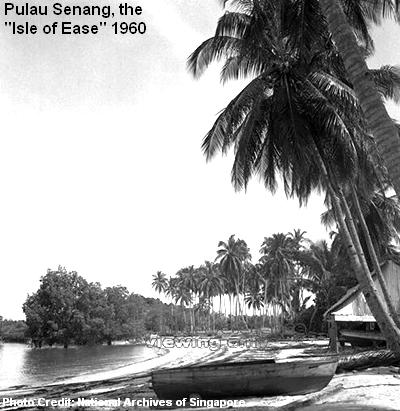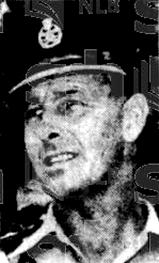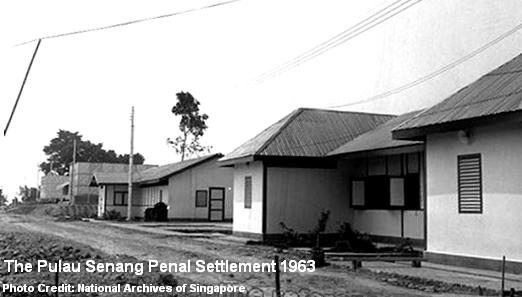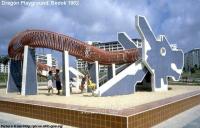Many movie fans are familiar with Chow Yun-Fat’s blockbuster “Prison on Fire”, a 1987 Hong Kong classic that featured inmates rioting against the prison authorities. Few, however, are aware that a similar incident had happened in Singapore in the early sixties.
A Turbulent Period
It was 1963, a year of turbulence and instability in Singapore. In January that year, Indonesia President Sukarno had declared Konfrontasi against the new Federation of Malaysia, in which the Malaya Peninsula was joined by Sabah, Sarawak and Singapore. Domestically, some 100 demonstrators marched their way to City Hall in April to protest against the arrests of left-wing activists and trade unionists. In August, a 100,000-strong “blood debt” mass rally took place at the Padang, demanding Japan to pay a $50-million compensation for their war atrocities in Singapore.
The violent Pulau Senang riot on 12th of July added further shocks to an already unstable Singapore society.

Gangsterism and the Isle of Ease
The People’s Action Party (PAP), Singapore’s new self-government in 1959, was determined to eradicate gangsterism and secret societies. It was estimated that there were as many as 120 gangs, such as the Ang Hor Tiap, Sio Koon Tong, Tiong Neng Tok, Sri Tong and Loh Kuan, and more than 10,000 active secret society members in Singapore. Rival clashes occurred almost every week, resulting in dozens of deaths. A thousand gangsters were arrested each year.
 The outdated prison system soon could not cope with the continuous arrests. Its overcrowding and hygienic issues forced the authority to explore new ideas and solutions. By early 1960, a Pulau Senang Settlement proposal was drawn; its objective was to solve the existing issues and also to help the gangsters work their way back to the society through hardship and sweat.
The outdated prison system soon could not cope with the continuous arrests. Its overcrowding and hygienic issues forced the authority to explore new ideas and solutions. By early 1960, a Pulau Senang Settlement proposal was drawn; its objective was to solve the existing issues and also to help the gangsters work their way back to the society through hardship and sweat.
Pulau Senang, or “Isle of Ease” in Malay, was then an uninhabited coral island that laid 13km away from the mainland of Singapore.
The Island Experiment
It was believed that the hardcore criminals and violent gangsters, with no regards for laws and orders, were forced into the tough circumstances due to lack of jobs and security. Through disciplined means, they could be reformed and would, one day, be accepted into the society again.
 At least one person, Irishman Daniel Stanley Dutton, held this belief. A born leader and the superintendent of the Prison Department, Dutton strongly believed that no man was born evil, and a second chance should be given to those who were willingly to change for the better. It was a noble aspiration, but Dutton’s iron-fist rule also meant that his prisoners were subjected to his harsh disciplinary methods, one of the reasons that might have incited the riot.
At least one person, Irishman Daniel Stanley Dutton, held this belief. A born leader and the superintendent of the Prison Department, Dutton strongly believed that no man was born evil, and a second chance should be given to those who were willingly to change for the better. It was a noble aspiration, but Dutton’s iron-fist rule also meant that his prisoners were subjected to his harsh disciplinary methods, one of the reasons that might have incited the riot.
In May 1960, the penal reform experiment officially started. Dutton and his 50 prisoners landed on Pulau Senang, and began developing the bare island immediately. Other detainees subsequently arrived in batches of 30. Within a short period, the island, no larger than 227-acres big, was turned into a self-sufficient rehabilitation centre with roads, reservoirs, workshops, farms and even a sports ground.
An Initial Success
The Pulau Senang experience was a success at the beginning. In just two years, over 250 prisoners, most of them Chinese secret society members, went through the reform system. After spending a year in Changi prison, the prisoners had the option to redeem themselves at Pulau Senang. They were given various manual tasks upon their arrivals, and each of them was accessed by Dutton himself every month. If the prisoners’ performances were satisfactory after six months or so, they would be released back to the mainland. A government department would help them settle down and find suitable jobs. Dutton, however, would not hesitate to send any rebellious or resentful individual back to jail.

The 40-plus years old Daniel Dutton was a confident man. Nicknamed “The Laughing Tiger”, he was the sole European on the island, and had only three assistants, two Chinese and one Ceylonese, to help him. There were no firearms in the settlement. Dutton even allowed minimum supervision of his prisoners, believing that they would not escape. He also laughed it off when his informers told him that the hardcore gangsters were plotting to kill him.
The Violent Riot
By 1963, the number of detainees on Pulau Senang had ballooned to over 300. The island security, headed by Dutton, was less than fifty. The riot on the fateful day of 12th July was believed to be sparked off by the deportation of 13 detainees who had been working on the construction of a jetty. There was already a growing resentment when the 13 men were ordered to work only during the low tides, regardless of day or night. Their fatigue turned into anger after Dutton demanded nothing but hard work and results.
When the crowds became rowdy in the morning, Dutton refused to call for reinforcement from the mainland police or the coastal guards. He was confident that the majority of the detainees would stand by him against the “few” rebellious ones. By the time Dutton realised he could not control the hostile situation, it was all too late.
The island, which the detainees took three years to build and develop, was practically destroyed in just 40 minutes. Buildings were burnt to the ground. Dutton and three of his assistants were brutally chopped to death by the rioters using axes and changkuls. Most of the rebels made no attempts to escape from the island. After the horrifying murders, they cheered and celebrated as though they were the new conquerors of Pulau Senang.

The Verdict
It was the first time in the legal history of Singapore that so many men were charged and convicted at the same time for capital offence. The case dragged on for two years. In June 1965, the appeal against their death sentences was rejected by the Privy Council. Out of the 58 detainees involved in the rioting, 11 were acquitted and 29 were jailed two to three years. The remaining 18, including the notorious Tan Kheng Ann, nicknamed “Robert Black”, and “Botak” Chia Yeo Fatt, were hanged in October 1965.

Pulau Senang’s penal reform experiment was eventually deemed as a failure. Investigations and studies were carried out to find out the reasons but the real motive of the riot remained inconclusive. After the incident, Pulau Senang was declared out of bounds. It would take many years before the island was converted into a Singapore Armed Forces (SAF) live-firing training ground along with Pulau Pawai and Pulau Sudong.
Published: 27 July 2013
Discover more from Remember Singapore
Subscribe to get the latest posts sent to your email.








Hi, I really enjoyed reading this blog. Keep it up for more interesting articles that we will not see in other media!
This account also appears in Alan Shadrake’s book – Once a Jolly Hangman, Appparently the 18 condemned to death were hung 6 by 6.
They were hanged 3 by 3 by Mr Darshan Singh.
really love this blog, thanks for the posts
Reblogged this on IAMKF'S ROOM.
My father was 1 of the prisoner there at that time. Lucky for him, was spare the death sentences. After knowing his childhood, I look up this articles to gather more information and it was really helpful.
really ure dad a prisoner..name?
Hi Linda, I’m currently researching for the topic.can help me out? Appreciate. My email is henhz15@gmail.com
Hi Linda, I’m Sarah and we are doing research on the story of Pulau Senang for a new TV documentary. Do you mind writing to me at sarah@very.sg? We have a few questions about this topic and would very much like your input on it. Thank you!
Hi Linda, we are currently looking for many audio interviewees for SG50 Singapore Memory Project. We would like to be given an opportunity to interview your father about the Pulau Senang riots as it is 1 of the various topics. Could you contact me at chloexiaowen@gmail.com? Your help is greatly appreciated.
Chloe Tang
Dear Linda,
I know that many people have already requested for your help on this thread but do you think you’ll be able to entertain another request please? I’m currently pursuing a Master of Philosophy in History and working on a dissertation on Pulau Senang. Any information you can provide would be most useful and I really would be immensely grateful if you could drop me an email at st638@cam.ac.uk. Thank you very much!
Regards,
S Tan
Hi Linda,
It’s amazing how you are so closely connected to this piece of Singapore history.
I’m working on a documentary about the Pulau Senang Penal Settlement and are looking for people with connections to the island to share what they’ve heard or experienced.
Our team will be ever so grateful if you’re willing to share your story with us. You can reach me at amirah@peddlingpictures.com if you’re interested in moving this conversation forward.
Thank you!
Best,
AMIRAH HARIS
I have an especial interest in the riot, as my father, Ralston Foenander, was also a prison officer, though stationed at Outram Road at the time. He had asked to be posted to Pulau Senang, but, fortunately, was rejected. On the day of the riot I remember coming home from school and seeing the Outram Road prison staff on standby outside the prison gate, ready to be sent to Pulau Senang if needed. I knew Mr. Tailford, who was savagely attacked, but survived, as I often used to play with his son, Derrick, while we were stationed at Changi, a few years before 1963. Anyway, I have been collecting much data on the riot, the persons at Pulau Senang, and those involved, and have a large amount of data, but still need much more. Any help will be most welcome. My e-mail is tfoenander@hotmail.com
Thank you in advance.
Terry Foenander (in Australia)
I neglected to add, in my previous post, that Dutton was not the only European on the island, at the time of the riot. Deputy Superintendent of the island, Mr. John William Tailford, himself was born in England, but had married a Singapore Eurasian. Hope this helps.
Chatted with my aunt just now, and was surprised she knew about this incident.
She’s in her 60s now, and she had heard about the riot when she was still a teenager.
As an ex-Naval Diver, I was one of the privileged few to set my foot on Pulau Senang in modern times. Our underwater demolition training exercises were conducted in the surrounding waters, and we usually setup our temporary base camps on the island. Though most of the buildings were gone, the foundations could still be seen. There was also a well on top of a hill where we took our bath.
On one side of the island there was a white sandy beach with very clear water, something which we would never find on mainland Singapore. Not too far off from the beach was a coral reef where we did our demolition training. Sadly, much of the reef was destroyed due to our activities.
If given a chance, I would really hope to visit the place again for its tranquility and remoteness.
Dutton’s wife Vicky was a radio deejay or anouncer then.Court testimony revealed that the murderers gouged out his eyes.
Only just found this item re Danny Dutton
My farther was one of Danny’s best friends, I believe they met while both were in the forces, Danny and his wife visited GB when married, i have photos somewhere of my Father & mother and Danny & Vicky his wife all together, when they were in the UK.
Hi!
My name is Gary here and I am involved in a documentary regarding Pulau Senang case and Daniel Stanley Dutton. Is there anyway that you can provide me with what you know about Daniel Stanley Dutton and how your father’s impression of him? My email address is Gary.Tan@mediacorp.com.sg
Hi Gary
Sorry its been a long time since i have visited this site, My father was in the Army Signal core and met Danny during his national service duties. He And Danny became very good friends, and Danny and his wife Vicky visited my parents in England during their friendship, i have news paper cutting re same, and a number of photos of Danny Vicky and my mother and father together in The UK.
Regards Phil
Hi Phil,
I’m really intrigued by your account and are hoping you will be able to share more about the close relationship your father had with Dutton.
I’m working on a documentary about the Pulau Senang Penal Settlement and are looking for people with connections to the island to share what they’ve heard or experienced.
Our team will be ever so grateful if you’re willing to share your story with us. You can reach me at amirah@peddlingpictures.com if you’re interested in moving this conversation forward.
Thank you!
Wow super cool. Thanks for the article!
Hi,
I am Jonathan Quak, I was staying at Pulau Pawai in the late 50’s. There was a good gentleman Mr Stevens Monterio (hopefully, I spelt correctly). He worked at Pulau Senang at that time, as a not very sure, and stay in Pulau Pawai, just near to Pulau Senang. He is a Catholic and treat every residents very well and help my poor family and me financially. I once stayed at his zinc roof house, when I was 9 years old.
We lost touch with him after we resettled to mainland Singapore.
My family and I wish to contact him. He could possibly, be in his 80’s by now an d do not know whether he is alive or not.
Could you please assist
Thank you.
Hi you may want to check this article regarding the family:
https://mothership.sg/2017/11/a-spore-family-were-the-only-people-living-on-the-reputedly-haunted-pulau-senang-from-1947/
If anyone currently interested in this now more than 60 year old piece of Singapore history please email to mcljames@me.com
I am the only son of Major Peter L. James who at the time of the Pulau Senang incident was the the Director of Prisons for Singapore. I believe my father was the last person to speak with ‘Danny’ Dutton on the direct radio telephone link from his office at Outram Road Gaol to Dutton’s office on the island. My late father, who was a former Superintendent of Changi Gaol in 1957/58 wrote an unpublished account of Superintendent Dutton’s involvement with Pulau Senang which I am prepared to make available to a researcher/publisher of my choosing.